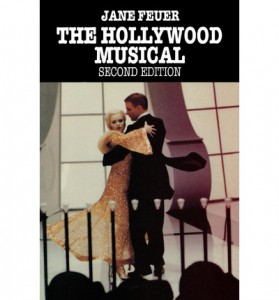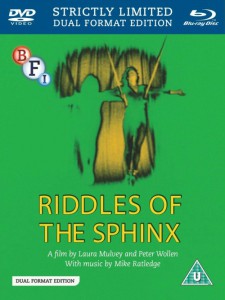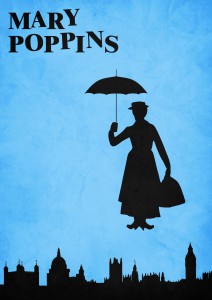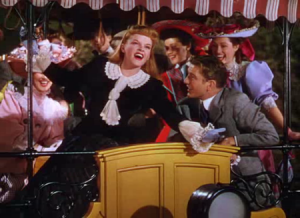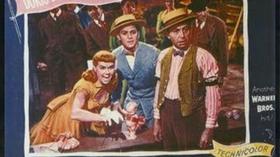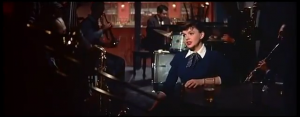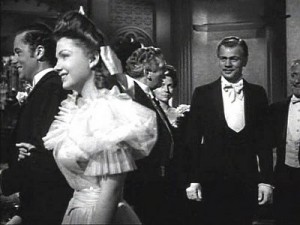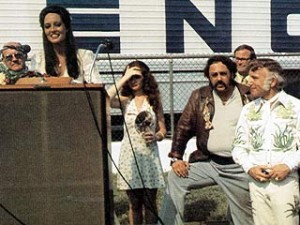From Film Quarterly, Vol. 36, No 4, Summer 1983. In 1996, during my first visit to Australia, I had the pleasure of “touring” with Feuer in various southern locations where we both lectured. -– J.R.
THE HOLLYWOOD MUSICAL
By Jane Feuer. Bloomingtion: Indiana University Press, 1982.
Since the advent of Pauline Kael and the anti-intellectual approach to popular genres that she has successfully championed, serious writing about the Hollywood musical that wishes to offer anything more than consumer tips, stray bit of gossip or trivial local evaluations — all useful enough services in their own right – has often had to remain doggedly academic in order to be recognized at all. Yet it is one of the rare virtues of Jane Feuer’s long-awaited The Hollywood Musical that, contrary to the ideological assumptions of the Kaelians and neo-Kaelians, it manages to be rigorously analytical and loads of fun at the same time. And thanks to Feuer’s witty style, the intellectual vantage point and the sense of play, far from seeming in any respect contradictory or inappropriate to its subject, work together to mutual advantage –- creating, like the musical itself, a high concentration of energy and grace under pressure.
Rick Altman’s excellent BFI Reader on the musical, which I reviewed in these pages last year, gave more than one foretaste of this possibility. The paradox is that Feuer herself, for all her capacity to straddle intellectual and entertainment categories, can’t quite seem to get over the puritanical all-American bias that there’s something slightly improper about it all. Already, in her preface, she’s arguing parenthetically that musicals give “the most intense…pleasure” to their audience because they’re “the least intellectualized” of genres – as if cognition were a priori an unintense, unpleasurable process. And in a way, it’s the very neatness of her overall academic distinctions that allows her to have her cake and eat it too without upsetting the whole dessert trolley – an eventuality she might have had to face if she were a journalistic critic, and had to confront the contradictions of the marketplace more directly.
Her overall thesis, as she herself points out, is built around a “seeming paradox”:
Theories of counter-cinema based purely on abstraction and cognition fail to take adequate account of the power of dominant cinema’s appeal to the emotions, an appeal that addresses itself in a systematic manner to basic human needs, albeit in a way which affirms the cultural status quo and forecloses change….Like Cubist paintings, musicals fragment space, multiplying and dividing the human figure into splits, doubles, alter egos. Like post-modern dance, musicals place a premium on an impression of spontaneity, group choreography and a naturalization of technique. Like Godard, musicals employ direct address, multiple and divided characters. Like Fellini, musicaIs insist on multiple levels of reality and on the continuity between dream images and waking life. Yet the Hollywood musical resembles none of these modernist works. Formally bold, it is culturally the most conservative of genres.
Something of a dialectician, Feuer largely proceeds through antinomies, as a perusal of her section headings quickly reveals: bricolage and engineering, the proscenium and “the world outside,” and the theme of popular art versus elite art, are three of the central polarities explored. The central focus remains the ideological positioning of the audience performed by musicals, and it is scarcely surprising that Feuer views this as an intricate set of checks and balances that counterpose the musical’s dreams of libidinal freedom with all sorts of mystificatory constraints. (In this respect, she might have further noted that, by being academically rather than poetically related to modernism, musicals bear a particularly strong ideological relationship to academic, predigested avant-garde films such as Riddles of the Sphinx and Sigmund Freud’s Dora — works that take great pains not to upset or offend the sensibilities of their pre-figured audiences, but strive, on the contrary, to confirm their academic presuppositions.
From this standpoint, Riddles and Dora have much more in common with Mary Poppins or Cabaret — setting aside the whole question of entertainment value — than they do with L’Age d’or or Zéro de Conduite or Weekend. Indeed, their very function is to make certain theoretical notions “hummable” — if not exactly danceable.)
Feuer is especially good in charting various instances of intertextuality in musicals. This is not only a matter of, say, the multiple ripoffs or spinoffs of Meet Me in St. Louis (such as Centennial Summer, State Fair and On Moonlight Bay) or the direct citations of That’s Entertainment, but also the complex resonances of Fred Astaire, Gene Kelly and Judy Garland (among others) as they develop from film to film, accumulating more and more supplementary meanings en route. Thus in the excellent discussion of Garland which concludes the book, and focuses on many of its preceding issues, the argument is persuasively made that the dramatic structure of A Star is Born is largely predicated on extra-filmic matters relating to Garland’s past at MGM and elsewhere more than any autonomous interest in Vicki Lester as a character. “The movement from [the film’s] opening number to Garland’s second number in the film, “The Man That Got Away,” parallels the movement from Garland’s MGM persona to her exposure to the public”; and spectators like myself who have always wondered why the dramatic impact of the latter number seems so asymmetrically disproportionate — an unbeatable early peak, rather like the ball sequence in The Magnificent Ambersons — are provided with a plausible context for an answer.
Thanks in part to the popular format of the BFI Cinema Series, which is edited by Ed Buscombe — whose only previous volume to date has been Colin MacCabe’s Godard: Images, Sounds, Politics, and whose avowed aim is to popularize difficult and/or unfamiliar work in recent film studies — many of Feuer’s best insights are highly compressed, economical without seeming unduly elliptical or aphoristic, The following conclusion to her chapter on “Dream Worlds and Dream Stages” is characteristic:
Musicals are unparalleled in presenting a vision of human liberation which is profoundly aesthetic. Part of the reason some of us love musicals so passionately is that they give as a glimpse of what it would be like to be free. We desperately need images of liberation in the popular arts. But the musical presents its vision of the unfettered human spirit in a way that forecloses a desire to translate that vision into reality. The Hollywood version of Utopia is entirely solipsistic. In its endless reflexivity the musical can offer only itself, only entertainment as its picture of Utopia The very terms it set up for itself, however unconsciously, as an apology for mass art, prevented the musical from ever breaking out of its self-imposed hermetic universe.
On the other hand, in a brief consideration of Nashville that follows—in a section on “The Evolution of the Audience in the Film”— Feuer succinctly shows how “entertainment indicts its own audience at the risk of losing it.” And in the course of clarifying multiple aspects of this paradox, she takes us through a pocket-sized history of her chosen genre that manages to be both fresh and informed, as well as a pleasure to read. — JONATHAN ROSENBAUM

